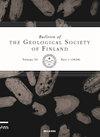上一次冰川消融期间影响芬兰中部北卡累利阿/奥卢冰原动力学的因素——冰下线性模式的激光雷达和DEM解释
IF 1.3
4区 地球科学
Q2 GEOLOGY
引用次数: 4
摘要
在大约13000 - 10000年前的最后一次消冰期间,SIS(斯堪的纳维亚冰盖)被分成几个活跃的、半独立的冰瓣。其中最大的是北卡累利阿/奥卢冰瓣(NKIL/OIL),覆盖了芬兰中部和俄罗斯卡累利阿西北部的大片地区。本文用反演模拟方法研究了NKIL/OIL的行为和冰下条件。该方法基于对NKIL/OIL活跃流动阶段形成的冰川期流线型线线图的识别和解释。在NKIL/OIL不同区域的7个子集中获得了线的DEM和LiDAR数据。结果表明,NKIL/OIL动力学受到第四纪沉积厚度、基岩岩性、构造和地形的强烈影响。由于这些因素,NKIL/ OIL通过几个流动通道运行,并在其整个生命周期中进行了多次回撤和再进循环。本文章由计算机程序翻译,如有差异,请以英文原文为准。
Factors affecting the dynamics of the North Karelian/Oulu Ice Lobe, Central Finland, during the last deglaciation – a LiDAR and DEM interpretation of subglacial lineation patterns
The SIS (Scandinavian Ice Sheet) became divided into several active, semi-independent ice lobes during the last deglaciation ca 13 000–10 000 years ago. The largest of them, the North Karelian/Oulu Ice Lobe (NKIL/OIL), covered vast areas in central Finland and in northwest Russian Karelia. This paper studies the behaviour and subglacial conditions of the NKIL/OIL with the inversion modelling method. The method is based on the identification and interpretation of mapped glacigenic streamlined lineations, formed during active flow stages of the NKIL/OIL. DEM and LiDAR data on lineations was obtained from seven subsets in different zones of the NKIL/OIL. Results indicate that the NKIL/OIL dynamics were strongly affected by pre-existing Quaternary sediment thickness, bedrock lithology, structures and topography. Due to these factors, the NKIL/ OIL operated through several flow corridors and had several retreat and re-advance cycles throughout its life span.
求助全文
通过发布文献求助,成功后即可免费获取论文全文。
去求助
来源期刊
CiteScore
1.30
自引率
0.00%
发文量
5
审稿时长
>12 weeks
期刊介绍:
Bulletin of the Geological Society of Finland (BGSF) publishes research articles and short communications in all branches of geosciences. Contributions from outside Finland are welcome, provided that they contain material relevant to Finnish geology or are of general interest.

 求助内容:
求助内容: 应助结果提醒方式:
应助结果提醒方式:


